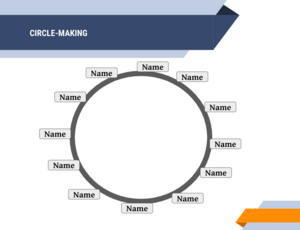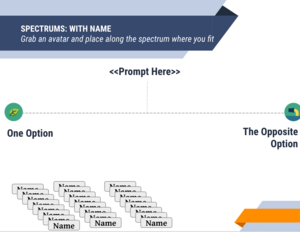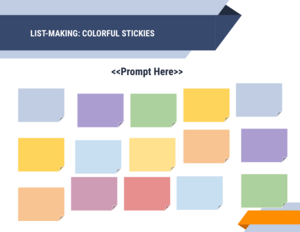Facilitation 101: Difference between revisions
| Line 73: | Line 73: | ||
'''Process:''' What steps will we take to achieve these outcomes and fulfill the purpose? | '''Process:''' What steps will we take to achieve these outcomes and fulfill the purpose? | ||
{| class="wikitable" style="border-collapse: collapse; width: 61.621%; height: 299px; background-color: rgb(255, 255, 255);" | |||
|- style="height: 67px;" | |||
| style="width: 11.5738%; background-color: rgb(153, 225, 217); height: 67px;" | Use the circle up tool | |||
| style="height: 67px; width: 28.9067%;" | | |||
Helps participants know who is in the room. You can use it for things such as introductions. | |||
| style="width: 18.4844%;" | [[File:Screen Shot 2023-07-07 at 11.00.34 AM.png|300x300px|left|middle|border]] | |||
|- style="height: 23px;" | |||
| style="width: 11.5738%; background-color: rgb(153, 225, 217); height: 23px;" | | |||
Use the spectrum tool | |||
| style="height: 23px; width: 28.9067%;" | | |||
Helps gauge where people are at. You can also do this anonymously with figures instead of names. | |||
| style="width: 18.4844%;" | [[File:Screen Shot 2023-07-07 at 11.04.11 AM.png|300x300px|left|middle|border]] | |||
|- style="height: 46px;" | |||
| style="width: 11.5738%; background-color: rgb(153, 225, 217); height: 46px;" | | |||
Use stickies | |||
| style="width: 28.9067%; height: 46px;" | | |||
Allows participants to share ideas. | |||
| style="width: 18.4844%;" | [[File:Screen Shot 2023-07-07 at 11.05.40 AM.png|300x300px|left|middle|border]] | |||
|} | |||
<p><span style="font-family: Montserrat, sans-serif;">'''The following are some 'energizer' activities that can help increase engagement:''' <ref>https://trainings.350.org/resource/gamesenergizersdynamicas/</ref> ''</span></p> | |||
{| class="wikitable" style="font-size: 14.4px; width: 100%; height: 364px; border-color: rgb(0, 0, 0);" | |||
|- style="height: 55px;" | |||
| style="width: 21.7495%; background-color: #c51f84; border-color: #000000; height: 55px;" | | |||
'''<span style="color: rgb(255, 255, 255);">Sam Went to Venus</span>''' | |||
| style="width: 78.2137%; height: 55px;" | | |||
*<span>Have the group stand in a large circle. </span> | |||
*<span>Explain the first person will say: “Did you hear?” </span><span>The second person (the person to their right) says: “What?” First person: “Sam went to Venus.” Second: “Really how?” First person: “She went to Venus like this!” – and the first person proceeds to make some repetitive motion. </span> | |||
*<span>Everyone in the circle repeats the motion (and continues repeating the motion). Then, the person to the </span><span>''left ''</span><span>of the first person repeats that same series: “Did you hear?/What?/Sam went to Venus./Really, how?/She went to Venus like this” and makes his/her own motion (which the whole groups repeats). </span> | |||
*<span>The process continues around the entire circle until ending when everyone has done it. (In large groups, this can be done in several separate groups simultaneously.)</span> | |||
|- style="height: 74px;" | |||
| style="width: 21.7495%; background-color: #c51f84; border-color: #000000; height: 74px;" | | |||
'''<span style="color: rgb(255, 255, 255);"><span>Something True About Yourself </span><span>''(from Gerald Gomani, Zimbabwe)''</span></span>''' | |||
| style="height: 74px; width: 78.2137%;" | | |||
*<span>Have each participant write down something true about themselves (anything), without their names, on a piece of paper. Then, have them wad it up. </span><span>''Then''</span><span>, throw snowballs at each other! After a few minutes of play, have the group read the snowballs.</span> | |||
|- style="height: 82px;" | |||
| style="width: 21.7495%; background-color: #c51f84; height: 82px; border-color: #000000;" | | |||
'''<span style="color: rgb(255, 255, 255);"><span>Strategy Stretch</span><span>'' (from Erika Thorne, USA)''</span></span>''' | |||
| style="height: 82px; width: 78.2137%;" | | |||
*<span>A simple stretching activity, but laced with activist principles. Start by having people get some space from each other. </span> | |||
*<span>Each stage involves a new direction to physically have people stretch their bodies. “Stretch upwards towards your vision / [while bending halfway at the waist] stretch your arms out towards your allies and colleagues / [while bending down at the waist] stretch down towards the grassroots, the source of your nourishment / [bending backwards] and bend backwards towards your ancestors, those people who support you from behind.”</span> | |||
|- | |||
| style="width: 21.7495%; background-color: rgb(197, 31, 132); border-color: rgb(0, 0, 0);" | | |||
<span style="color: rgb(255, 255, 255);" >'''<span><span></span></span>'''</span> | |||
<span style="color: rgb(255, 255, 255);" >'''Why… Because… ''(from Gerald Gomani, Zimbabwe)'''''</span> | |||
| style="width: 78.2137%;" | <span></span> | |||
*Have people on one half of the group write down a ''Why ''question (“Why is the grass green? Why is there suffering?” etc.). Have the other half write down a ''Because ''answer (“Because I said so. Because it can float.” etc.). | |||
*Give no indication for the purpose or what types of why questions or because answers people should write. Then – and this can be a hilarious exercise – go around the room and have the ''Why’s'' ask a question and get their answer from the ''Because’s''. | |||
|- | |||
| style="width: 21.7495%; background-color: rgb(197, 31, 132); border-color: rgb(0, 0, 0);" | | |||
<span style="color: rgb(255, 255, 255);" >'''<span><span></span></span>'''</span> | |||
<span style="color: rgb(255, 255, 255);" >'''Check in questions'''</span> | |||
| style="width: 78.2137%;" | | |||
*<span>A chance to hear everyone’s voice on something that’s not a work topic. Examples include: what’s a song that represents you? What’s an object around you that says something about you? What’s one thing you’re proud of from last week? What’s something people might not know about you? What do you appreciate about another team member?</span> | |||
|} | |||
== Structuring your agenda == | == Structuring your agenda == | ||
Revision as of 16:56, 26 July 2023
This page was created to provide tips and suggestions for activists related to facilitating meetings and events. This guide reflects several questions the HUB community has raised on facilitation.
The information included comes from existing organizer databases and resources and advice from movement thinkers. A special thanks to HUB advisor Amara Possain, who thoughtfully shared their expertise with the HUB team. Their knowledge is shared throughout. We encourage readers to share further ideas on how this page can be expanded upon and improved.
This guide includes... definers of good vs bad facilitation, tools for good facilitation, suggestions for increasing participant engagement and suggestions for managing group dynamics.
What do we mean by facilitation? [1] [2]
The role of a facilitator is to drive meeting or event participants towards clarity. Facilitation move things forward and build momentum. Facilitators also bring participants back to the purpose of the event/meeting. Remembering your purpose is key, so that when someone is taking up too much space, the facilitator can remind that you'd like to bring us back to the purpose and our goals. -Amara Possain, HUB advisor
In other words, the role of a facilitator and the purpose of facilitation is to: Source: adapted from Meeting Facilitation: The No-Magic Method (Berit Lakey) and Seeds for Change.
Take responsibility for helping the group stay on track and move through the agenda within the available time.
Suggest how to move the group forward, rather than making decisions or plans for the group.
Regulating the flow of discussion
Track decisions and milestones, providing clarity on the group's journey, clarifying and summarizing points
Prioritize the collective needs and goals of the group over individual within the group.
Note: A person who has strong opinions or significant investment in the decisions being made may find it challenging to facilitate effectively. In some situations, it can be helpful to have an external facilitator.
What makes for poor facilitation?
The following reflections were raised by CAN-RAC and HUB team members in a joint workshop developed and delivered by Amara Possain:
- No agenda, no steering, lack of organization
- Repetition
- Lack of momentum
- Not stepping in to help pull out the positives (groups tend to focus on negatives)
- Not stepping in when some people are taking up too much space
- Not knowing the audience and how to tailor facilitation
- Not stepping in to get people back on track, when people hijack space
- Low engagement and energy, lack of initiative
- Not being able to move past certain items
- People weaponizing meeting rules and knowledge of process
- Passive aggressiveness
- Unclear roles in non-hierarchical structure
- Interrupting each other
- “Outfacilitating" the facilitator - often around an unbalanced power dynamic
- Miscommunications / inability to diagnose where we departed in understanding
Key facilitation skills [3]
- Active listening enables us to hear what others are saying;
- Questioning helps clarify what people are saying, or supports people to explore their needs and come up with new possibilities;
- Summarising helps remind us of the key points in the discussion and check we have the same understanding;
- Synthesising is the skill that allows us to draw together different views and ideas to form one proposal that works for everyone.
Good facilitation should result in good meetings with [4] :
- Clearly defined and mutually understood goals.
- A well-defined process for effectively achieving those goals.
- Recognition that participants bring their personal preoccupations and emotions alongside their interest in the subject matter.
- Fostering a sense of involvement and empowerment, allowing participants to feel ownership over the decisions and able to take necessary actions.
Tools for good facilitation
The following tools were suggestions from HUB advisor Amara Possain.
Stop and POP [5]
Source: adapted from The P-O-P Model (Social Transformation Project, Leslie Sholl Jaffe & Randy Alford)
Purpose: Why? Why are we having this meeting? What is the purpose?
Outcomes: What do we want to accomplish as a result of this meeting?
Process: What steps will we take to achieve these outcomes and fulfill the purpose?
The following are some 'energizer' activities that can help increase engagement: [6]
|
Sam Went to Venus |
|
|
Something True About Yourself (from Gerald Gomani, Zimbabwe) |
|
|
Strategy Stretch (from Erika Thorne, USA) |
|
|
Why… Because… (from Gerald Gomani, Zimbabwe) |
|
|
Check in questions |
|
Structuring your agenda
1) Opening: Something to help gather people, focus on the meeting, to make them feel connected to each other.
2) Agenda review: Make the agenda visible for participants with time markings. Review, make any changes, then agree to move ahead with meeting. Ideally include approx. time parkings.
- Note: Consider the dance of time; give a range of time to help people get a sense for how long you'll spend on things, but also balance when more or less time needs to go to certain things
3) Main items: Start with something easy to build momentum, then move on to harder items. Finish with something short and easy to provide hope for next time.
4) Evaluation and closing: A quick opportunity for people to express their feelings, provide a sense of closure, and help improve the next meeting.
Suggestions for increasing participant engagement
From Amara Possain, HUB advisor:
- Use the opening to build trust and ground attendees.
- Engage people early and often - set the tone in the first few minutes.
- Alternate structures / modes so there are many ways to participate.
- Break things up and take breaks, especially in longer meetings with many big and/or difficult items.
- Break up who is speaking - arrange for others to present whenever possible.
- Probe and test for agreement - be suspicious when agreements are reached too easily.
- Notice and celebrate when we do get agreement — even small ones!
Online tips: Turn on captions, stay off mute in smaller groups, have people call on the next person in a go-around.
Suggestions from Daniel Hunter (350.org's training director). [7]
*Note these are appropriate for both in-person and online meetings/events!
The following are some 'energizer' activities that can help increase engagement: [8]
|
Sam Went to Venus |
|
|
Something True About Yourself (from Gerald Gomani, Zimbabwe) |
|
|
Strategy Stretch (from Erika Thorne, USA) |
|
|
Why… Because… (from Gerald Gomani, Zimbabwe) |
|
|
Check in questions |
|
Suggestions for managing group dynamics
From Amara Possain, HUB advisor and Meeting Facilitation: The No-Magic Method (Berit Lakey)
|
Setting the tone |
|
|
Specific practices |
|
|
Handling specific situations |
|
If you have any suggested revisions or additional resources to share related to the above content, please email them to kenzie@lehub.ca.

- ↑ https://www.trainingforchange.org/training_tools/meeting-facilitation-the-no-magic-method/
- ↑ https://www.seedsforchange.org.uk/facilitationmeeting
- ↑ https://www.seedsforchange.org.uk/facilitationmeeting
- ↑ https://www.trainingforchange.org/training_tools/meeting-facilitation-the-no-magic-method/
- ↑ http://stproject.org/
- ↑ https://trainings.350.org/resource/gamesenergizersdynamicas/
- ↑ https://trainings.350.org/resource/online-monster-manual/
- ↑ https://trainings.350.org/resource/gamesenergizersdynamicas/


